In the Studio: Margaret Curtis
“I became very interested in what was behind a facade, or what was underneath, w...

Teresa Baker is mixed-media artist and 2022 Joan Mitchell Fellow. An enrolled member of the Three Affiliated Tribes in Western, ND, Baker currently lives and works in Los Angeles, CA. We interviewed her about her recent work and creative practice in March 2023. The following is an edited transcript of that conversation.
I make mixed-media, abstract, large-scale work that references landscape, specifically that of the Northern Plains. For me, these works embody culture, spirituality, and our relationship as humans with land—that reciprocity and respect. Through an intuitive practice driven by process and formal concerns, I respond to the materials and make decisions based off of their characteristics—how far I can push them, what their restrictions are. Each new piece feels like a puzzle that I'm solving.
When I'm by myself in the studio, engaging with these materials, that's the exciting part. It feels very physical. I'm really interested in live performance and theater and the visceral-ness that happens in those situations. That time in my studio feels like a conversation, with this back and forth between me and the work and the objects.
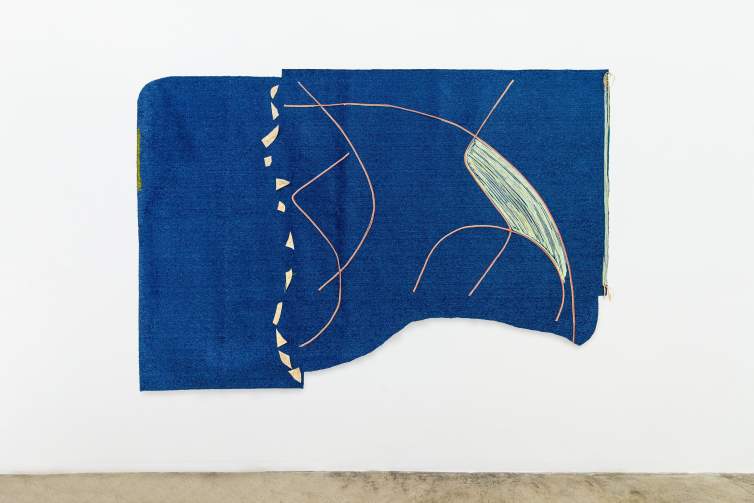
I love this formal, abstract conversation, because it doesn't have to be bound by the verbal language. There's a limit to really describing our senses and felt things through language. I feel like abstraction is a way to do that, and to ideally have more of that visceral “felt” sense through the work.
I've become really focused on capturing space in my work. In my pieces, I generally leave large swaths of the ground, which is usually artificial turf, showing, and really kind of hone in on details and subtleties within that. I find that I talk about landscape with my abstractions because I think there's a way of coming to the work that is similar to how we go into landscape. There's a presence, there's a focus on details. It's like you kind of go into this internal place and space, and you become very aware of how small you are, and how big these spaces are.
My father worked for the National Park Service, so we grew up outside a lot and in smaller communities throughout the Midwest, Northern Plains area. I really credit that to forming the way that I see. That’s the foundation—the memory of those places from my childhood. I kind of blurred them together because we moved quite a bit throughout the same areas. But I also am influenced by where I currently live, or wherever I'm making the work, whether it's through color or other factors. Living in LA right now, I feel like I'm adding more to the work than usual. There's just more happening here, and there's this mishmash of the city that kind of comes into the work.
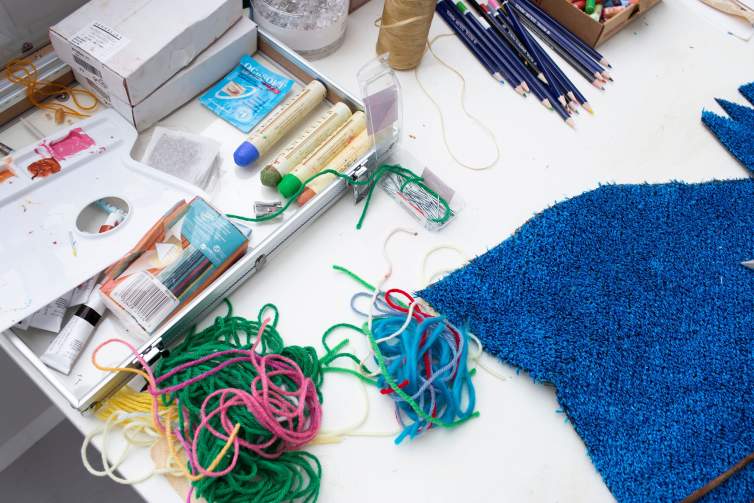
In a lot of ways, where I'm at right now in my practice is because of a 10 year investigation of materials that came before, because my work is so process-based. It's basically been a search for materials. I definitely tried the canvas and the square and the rectangle, and I found that the boundaries of those shapes weren't enough for me. I didn’t feel like the work was, in a sense, feeling alive. I'm really interested in these works being sort of autonomous in a way, which is why I see them as always being a continuation of each other. I rarely make the same exact shape for each one. Instead, it's more about how it evolves and becomes its own shape.
So I worked with canvas and polyurethane foam and felt, and I've been on this long search for the material that would be the ground, and would be the surface—one that would hold its own shape and be sturdy in that way. There's history with any material, but I wanted one that was not so consumed by history in the way that felt or canvas are, that had a freedom. That's how I ended up with Astroturf. But it was also by chance, which I think is the beauty of process, because you get to try something that you wouldn't expect, and be really delighted with the results.
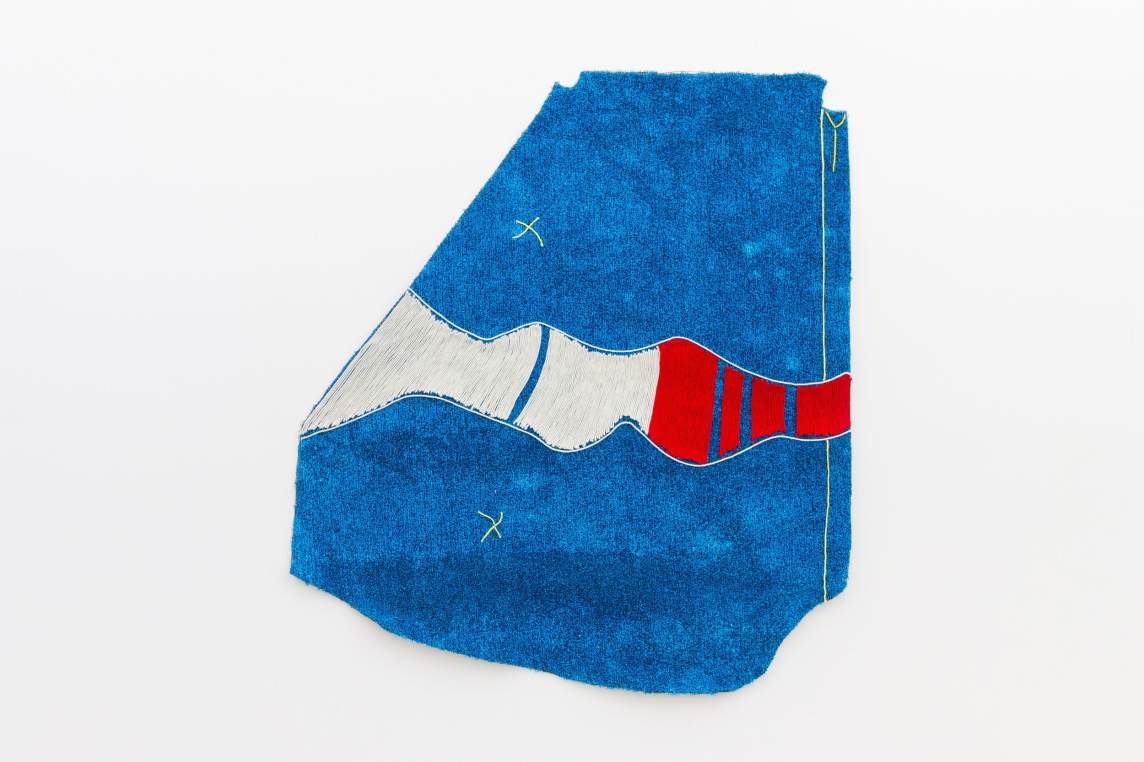
I came across the Astroturf that I now use in my work in Texas, when I lived there, in a Home Depot. It was a bright blue, and I had just never seen that before. Growing up in the Plains, we don't use Astroturf in the way that I think some cities do or areas like Southern California. So for me, it felt really alien.
What is nice at this point is that I don't know if I even “see” the Astroturf anymore. It's just become this kind of working system where it is my canvas, but it's doing everything I want canvas to do that canvas doesn't do. It's giving me these colors to react to, it's giving me a texture to react to. Yarn sticks to the Astroturf, so it feels like a drawing or it feels like a painting.
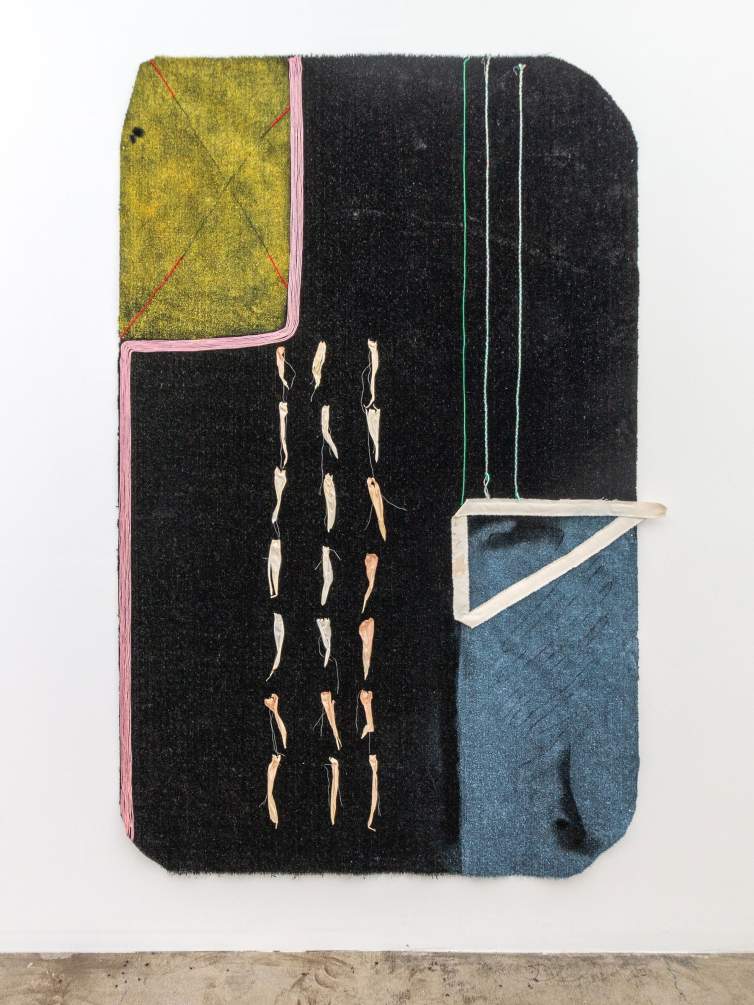
I also like to bring natural materials into the work. So right now, I use materials that are traditional to my tribe, like buckskin, willow, buffalo hide, and parfleche. They become additional ways to explore texture and shapes, but they also ground my objects in a long tradition of materials that hold meaning, either functional or spiritual. They function within the work in a new way, but they also sort of hold onto that lineage or identity and bring that forward. And I also see a connection in our current state of the world, where these kinds of materials are acting as reflectors for a life we're all living in the natural and the artificial, and how we're replacing land with this artifice.
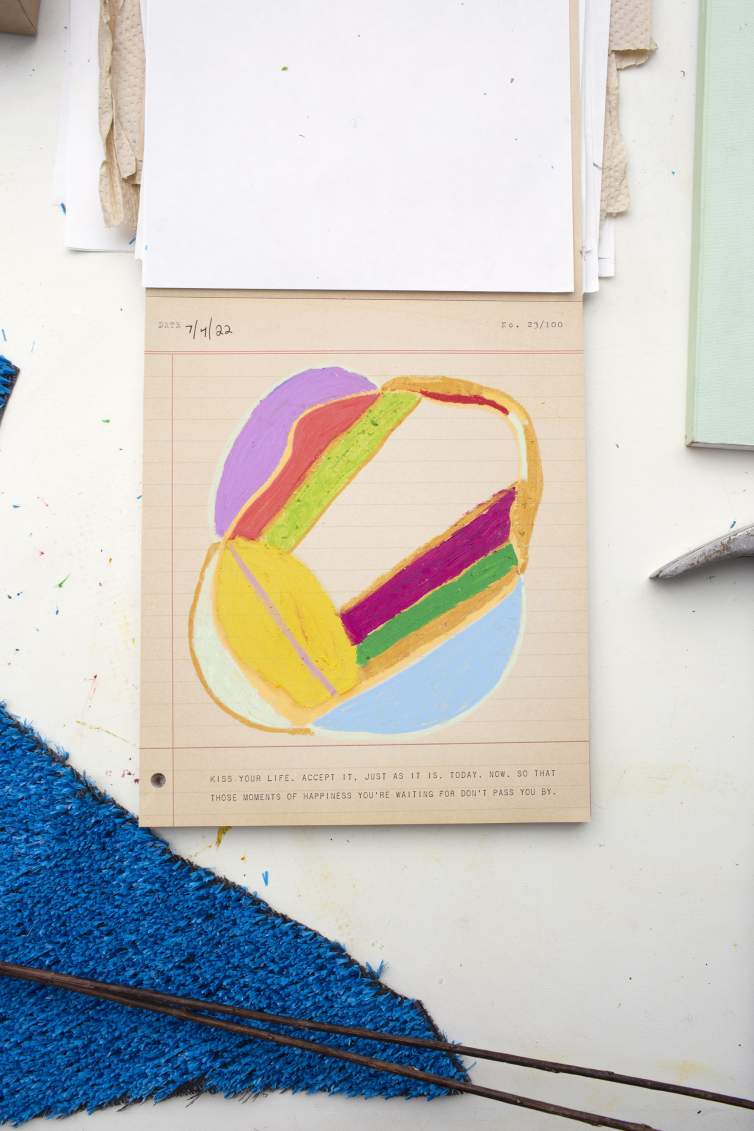
Generally, my starting place is that I do a series of drawings. My drawings are really a separate practice that is concurrent to my large-scale work, although I've recently started taking the shapes from the drawings. They help me get out color and shape ideas really fast, in a way that's not super precious.
There's a new thing in my life, which is that I have a son who's a year and a half old. We're transitioning out of this a little bit as he gets older, but when I rock him to sleep, I spend that time thinking about the work. Either a shape will pop into my mind, or if I'm at a point where I'm struggling with a piece and I'm trying to figure out what the next step is, I'll take that time when I'm in this dark room and I’m rocking Alton to sleep, and I'll spend a little time visualizing the work. Sometimes I figure out the next step or I'm like, "Oh, this is where I need to take the work." I also feel like he's a little bit of a collaborator, maybe unknowingly so.
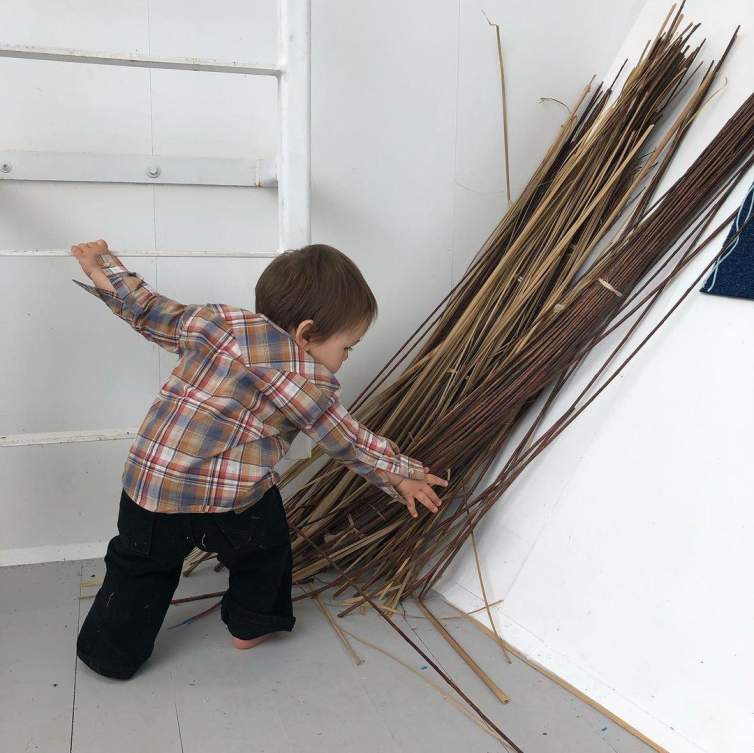
I also love going on drives, if I'm feeling kind of stuck, to stare out the window and just process what the work is about. Usually I'm being driven, I should say, by my husband. Sometimes I get titles for my show while we're on some sort of road trip and I'm just staring out the window and processing the work from afar. There's something about being away from it sometimes and visualizing and thinking about it that really helps me tune into what's happening.
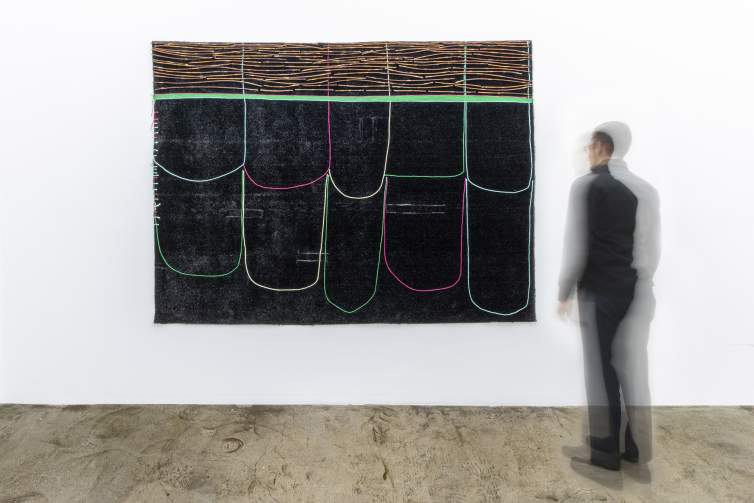
The things I do are not so linear, but rather they kind of bounce around, or maybe move in a circle around the next show or idea. And they're finished when I can't place them. I can't control associations from other people, but for me I know it's finished when I look at it and I can't say, you are this or you are that. There's no really clear place where I can identify it. It's getting to live between all of the categories, and create its own space.
My hope is that when people see my work, they have some sort of energetic or visceral response—that it moves them in some way. My work is usually quite large—often around nine feet high and around five to six feet wide. So I think that there is a sense that they are immersive. The feeling that I usually get from them is that it's almost like they could hug you. There's a warmth from them, and there's this comfort that they offer. So I guess I just hope that it offers something new for folks, but is also familiar at the same time. The familiarity, for me, is the landscape part or the feeling of that land. And then it’s new in terms of it being an object, and kind of combining all of those elements.
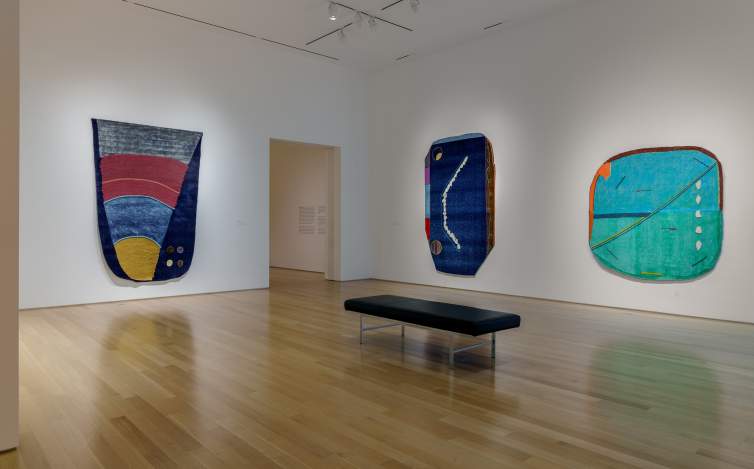
I just completed five works for the Nerman Museum of Contemporary Art, for a show called Sun Drinks White. The title is from a poem by Kimberly Blaeser, and there are three other artists in the show who all explore or touch on landscape in their own way: Marie Watt, Rashawn Griffin, and Mark Cowardin. The show opened in Kansas City in March, and when I set out to think about these pieces, I was really interested in the seasons and thinking about the way that the plains feel as we transition from winter into spring. There's still a coldness and a harshness, but there's also more light. It’s a volatile season, but it's also really hopeful.
In thinking about my color choices, and even just the color that happens in nature, I think there's a way that the light hits in that part of the world. There are a lot of greens and some blues. Obviously at this time of year green is emerging, and I was thinking about things being really crisp and sort of limey. I wouldn't say the work has a lot of lime, but that was the color feeling that I wanted to capture. A lime feeling.
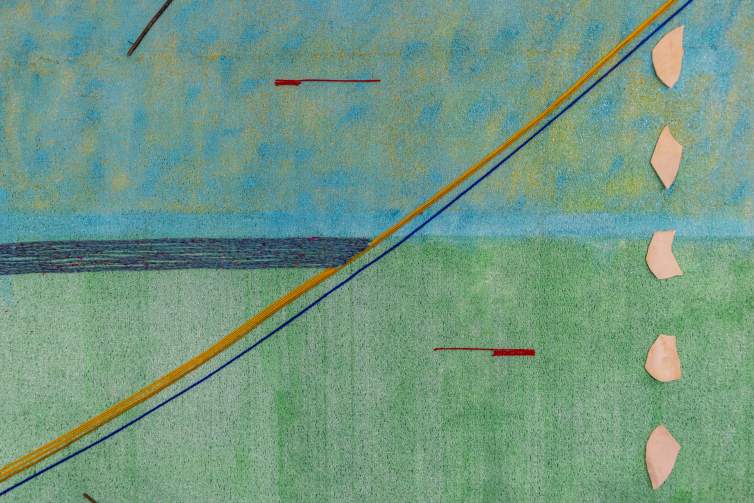
Then there are just those expanses—the stretches of plains and the vistas. My tribe is from the North Dakota area, so I’ve been thinking about the sort of historical relationships between these areas, some of those trade routes perhaps, or some of that movement that was happening, the trails. Those were the ideas that were circulating as I was making the work for this show.
Aside from the Nerman Museum show, I have a very full spring, summer, and fall that I'm preparing for. I have two group shows, one at the Anthony Meier Fine Arts in San Francisco, curated by Saif Azzuz, and the other is at Gerald Peters Contemporary in Santa Fe. Then, I'll have a paired down and intimate solo presentation at Halsey Mckay in the Hamptons from July 8–31. I'll have a solo show with my gallery here in Los Angeles, De Boer Gallery, at the beginning of September, and I will also be a part of Made in LA this fall at the Hammer Museum.
Interview and editing by Jenny Gill. Learn more about Teresa Baker’s work here.